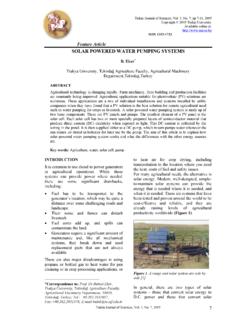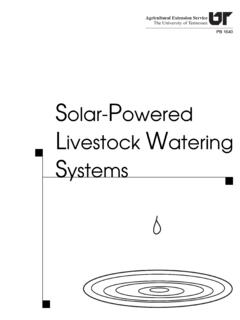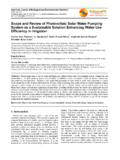Transcription of JJMIE Volume 5, Number 3, June 2011 ISSN 1995 …
1 JJMIE Volume 5, Number 3, june 2011 issn 1995-6665 Pages 273 - 280 Jordan Journal of Mechanical and Industrial Engineering Design of Photovoltaic water pumping System and Compare it with Diesel Powered Pump * Jordan Petroleum Refinery Company (JPRC), Irbid LPG Filling Station Hall, PO Box 3396 Amman 11181, Jordan * Corresponding author. e-mail: Abstract In locations where electricity is unavailable, other means are necessary to pump water for consumption. One option is a photovoltaic (PV) pumping system. Advantages of PV pumping systems include low operating cost, unattended operation, low maintenance, easy installation, and long life. These are all important in remote locations where electricity may be unavailable. So far, in the development of this research, the focus has been to estimate the available radiation at a particular location on the earth s surface and then analyzed the characteristics of a photovoltaic generator and a photovoltaic network.
2 The purpose of this research is to examine all the necessary steps and key components needed to design and build a pump using photovoltaic system. 2011 Jordan Journal of Mechanical and Industrial Engineering. All rights reserved Keyword: Design load; Site condition; Annual radiation; Life Cycle Costs; Break-even point; Battery capacity1. Introduction Most of the increase in the area of irrigated land in the world has been through the increasing use of engine-driven pumps. However, the increasing price of oil-based fuel has reduced the margin to be gained by farmers from irrigation, since food prices have generally been prevented from rising in line with energy costs. Despite present short-term fluctuations in oil prices, conventional oil-based engine-driven power sources and mains electricity are expected to continue to increase in the longer term. If we are to decrease our dependence on imported oil, we have to find methods for energizing irrigation pumps that are independent of imported oil or centralized electricity.
3 Solar radiation as a source of energy is. Of course, the epitome of the clean. sustainable energy technology. except for residues possibly arising out of the manufacture of solar component ( semiconductors), solar technology have very low environmental impacts. The environmental impacts of solar system in operation are very low and the source is, for us inexhaustible. The designer should specify components in the following order: Choose place and mounting method for modules, select modules. Estimate of the electricity Demand. Estimate the overall system losses. Prepare full list of parts and tools to order. Small Comparison between Solar PV & Diesel and gasoline pumps: Table 1: Comparison between Solar PV & Diesel and gasoline pumps. Type Advantages Disadvantages Solar PV Unattended operation High capital costs Low maintenance water storage is require for cloudy periods Easy installation Repair often require skilled technicians Long life Diesel and Gasoline Pumps Quick and easy to install Fuel supplies erratic and expensive Low capital costs High maintenance costs Widely used Short life expectancy Can be portable Noise and fume pollution 2.
4 Components of the System Photovoltaic panels: A solar-powered water pumping system is made up of two basic components. The first component is the power supply consisting of photovoltaic (PV) panels ( ). The smallest element of a PV panel is the solar cell. 2011 Jordan Journal of Mechanical and Industrial Engineering. All rights reserved - Volume 5, Number 3 ( issn 1995-6665) 274 Figure 1: Photovoltaic (PV) panels. Each solar cell has two or more specially prepared layers of semiconductor material that produce direct current (DC) electricity when exposed to light. This DC current is collected by the wiring in the panel. It is then supplied either to a DC pump, which in turn pumps water whenever the sun shines, or stored in batteries for later use by the pump. Manufacturers normally rate voltage (volts) and current (amps) output from PV panels under peak power conditions. Peak power (watts=volts x amps) is the maximum power available from the PV panel at 1000 W/m solar irradiance (amount of sunshine) and a specified temperature, usually 25 C (77 F).
5 Typical output from a 60-watt PV panel is shown in Table 2. The amount of DC current produced by a PV panel is much more sensitive to light intensity striking the panel than is voltage generated. Roughly speaking, if you halve the light intensity, you halve the DC current output, but the voltage output is reduced only slightly. Table 2: Typical output from a 60-watt, 12-volt photovoltaic panel. Maximum power 60 watts Maximum power voltage volts Maximum power current amps Individual PV panels can be wired in series or parallel to obtain the required voltage or current needed to run the pump. The voltage output from panels wired in series is the sum of all the voltages from the panels. For example, the maximum voltage output from two of the 12-volt PV panels wired in series is volts. Thus, a 24-volt DC pump requires a minimum of two, 12-volt panels wired in series. The current (amps) output from these same panels wired in series is equal to the current (amps) output from an individual panel, amps.
6 The voltage and current output from panels wired in parallel is the exact opposite of series-wired panels. For panels wired in parallel, the current (amps) output is the sum of all the currents (amps) from the panels and the voltage is equal to the voltage output from an individual panel. Solar (DC) water pumps: The other major component of these systems is the pump. Solar water pumps are specially designed to use solar power efficiently. Conventional pumps require steady AC current that utility lines or generators supply. Solar pumps use DC current from batteries and/or PV panels. In addition, they are designed to work effectively during low-light conditions, at reduced voltage, without stalling or overheating. Although wide ranges of sizes are available, most pumps used in livestock-watering applications are low Volume , yielding 7-15 liters of water per minute. Low- Volume pumping keeps the cost of the system down by using a minimum Number of solar panels and using the entire daylight period to pump water or charge batteries.
7 Some solar pumps are fully submersible, while others are not. The use of submersible pumps eliminates potential priming and freezing problems. Most solar water pumps are designed to use solar power most efficiently and operate on 12 to 36 volts DC. Many solar pumping systems use positive displacement pumps that seal water in cavities inside the pump and force it upward. Their design enables them to maintain their lift capacity all through the solar day at the slow, varying speeds that result from varying light conditions. Positive displacement pumps include piston and jack pumps, diaphragm, vane and screw pumps. Centrifugal-type pumps that impart energy to the water using a rotating impeller are typically used for low-lift or high- Volume systems. Centrifugal pumps start gradually and their flow output increases with the amount of current. For this reason, they can be tied directly to the PV array without including a battery or controls.
8 However, because their output drops off at reduced speeds, a good match between the pump and PV array is necessary to achieve efficient operation. Pumps, because of their mechanical nature, have certain well-defined operating properties. These properties vary between types of pumps, manufacturers and models. The amount of water that a solar pumping system will deliver over a given period of time (usually measured in liters per minute (LPM) or liters per hour (LPH)) depends upon the pressure against which the pump has to work. The system pressure is largely determined by the total vertical pumping distance (the vertical distance between the water source and the watering tank) referred to simply as elevation head. It is roughly equal to an increase of one bar for every meters of elevation head. Simply put, as the vertical pumping distance increases, the amount of water pumped over a given period of time decreases.
9 When system friction losses and discharge pressure requirements (if any) are added to elevation head, the total system head can be determined. Pump manufacturers publish information that describes how each pump will perform under varying operating conditions. The expected flow rates and minimum recommended solar panel sizes for a typical 24-volt, positive-displacement, diaphragm-type submersible pump are shown in Table 3. The choice of pump depends on water Volume needed, efficiency, price and reliability. 2011 Jordan Journal of Mechanical and Industrial Engineering. All rights reserved - Volume 5, Number 3 ( issn 1995-6665) 275 Table 3: Estimated flow rates in liters per minute for a typical positive-displacement, 24-volt diaphragm type pump. Total head (meter) Flow Rate (liter/min) Current in ampere 0 None Shaded areas- Two 53-watt panels in series. Shaded areas Two 70-watt panels in series.
10 Pump controller: The primary function of a pump controller in a battery-coupled pumping system is to boost the voltage of the battery bank to match the desired input voltage of the pump. Without a pump controller, the PV panels operating voltage is dictated by the battery bank and is reduced from levels, which are achieved by operating the pump directly off the solar panels. For example, under load, two PV panels wired in series produce between 30 to 34 volts, while two fully charged batteries wired in series produce just over 26 volts. A pump with an optimum operating voltage of 30 volts would pump more water tied directly to the PV panels than if connected to the batteries. In the case of this particular pump, a pump controller with a 24-volt input would step the voltage up to 30 volts, which would increase the amount of water pumped by the system. 3. Solar-Powered water pumping System Configurations There are two basic types of solar-powered water pumping systems, battery-coupled and direct-coupled.






